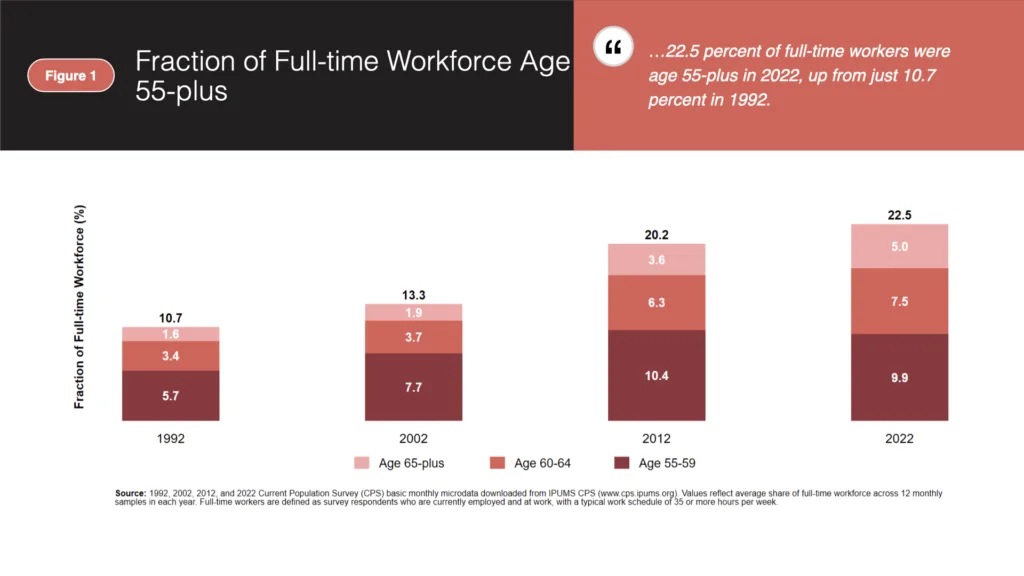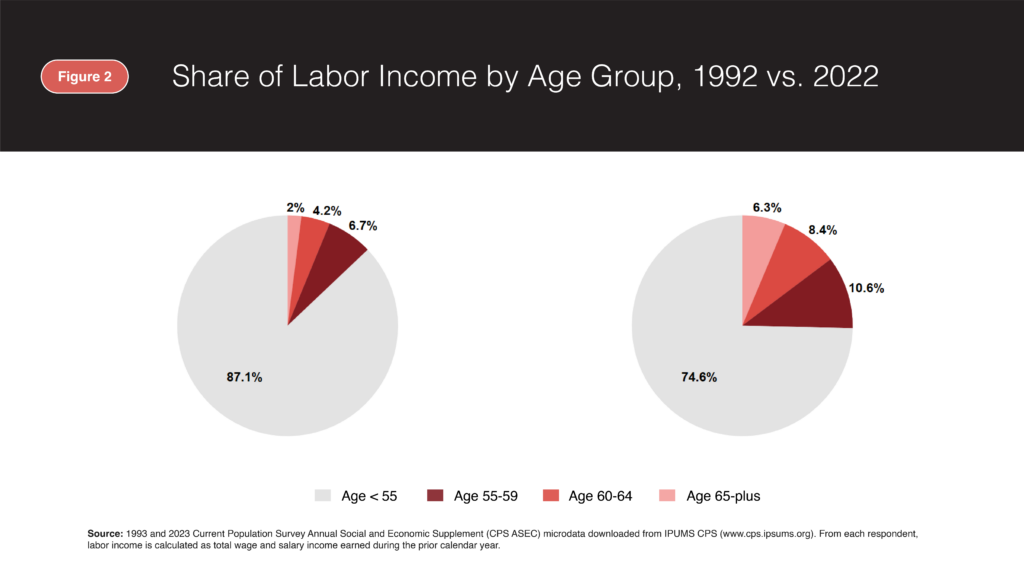Key Takeaways
- Labor market policies and employment practices have historically been designed with prime-age workers (i.e., those age 25-54) in mind, yet the economic importance of older workers is growing rapidly.
- Workers age 55-plus accounted for 22.5 percent of full-time employment in 2022, up from just 10.7 percent in 1992.
- In 2022, 25.4 percent of labor income was earned by workers age 55 or older, up from just 12.9 percent in 1992.
- The productivity of America’s workforce depends on developing labor policies and employment practices that meet the needs of every generation.
For decades, labor market policies and employment practices have emphasized the “prime working age” population, which includes people age 25-54. This focus stems from the sheer size of the group and its reliably high labor force participation. In contrast, workers age 55 and older have historically been a much smaller population with lower labor force participation; consequently, their role in the labor force has received comparatively little attention or care. However, unprecedented changes in the workforce have greatly amplified the importance of older workers and underscored a fundamental truth: The future success of America’s workforce depends on developing labor policies and employment practices that meet the needs of every generation.
Workers age 25-54 receive so much attention from policymakers and labor market analysts because they have historically represented a large majority of America’s full-time workforce and accounted for a correspondingly large share of critical economic contributions such as labor income, consumer spending, and tax revenue. Conversely, relatively few full-time workers were age 55 or older just three decades ago. Since then, the U.S. population has aged significantly, and people are increasingly choosing to work later in life. As a result, 22.5 percent of full-time workers were age 55-plus in 2022, up from just 10.7 percent in 1992. This dramatic increase was mostly due to the growing role of workers age 60-plus, a group whose representation in the full-time workforce rose from five percent in 1992 to 12.5 percent in 2022.

As their role in the workforce grows, older workers earn a correspondingly higher share of labor income. The figure below illustrates this by comparing shares of labor income for age groups in 1992 and 2022.1 In 1992, workers under age 55 earned 87.1 percent of labor income, with workers age 55-plus earning the remaining 12.9 percent. By 2022, the share of labor income earned by those age 55-plus had skyrocketed to 25.4 percent, largely because the share earned by workers age 60-plus more than doubled (from 6.2 percent to 14.7 percent). This shift has had far-reaching implications, including a greater reliance on older workers for economic contributions such as consumer spending and tax revenue.

Awareness about the growing role of older workers is rising quickly. For example, a pandemic-driven decline in labor supply among people age 65-plus has contributed to significant and persistent labor shortages in many parts of the workforce. Preventing outcomes like this in the future will require labor policies and employment practices that meet the needs of all workers, regardless of age. Recent work from AARP, including the Living, Learning, and Earning Longer initiative, a report examining the business case for healthy longevity, and extensive research on the Longevity Economy®, highlights this fact and identifies innovations that can build a more age-diverse workforce. Efforts of this kind empower workers of every generation, yielding widespread economic gains for businesses, employees, and society at large.
- The income data used in Figure 2 come from the 1993 and 2023 waves of the Annual Social and Economic Supplement (ASEC), which is administered as part of the March Current Population Survey (CPS). In these data, reported labor income reflects total wage and salary income earned during the prior calendar year. ↩︎

 "
"
